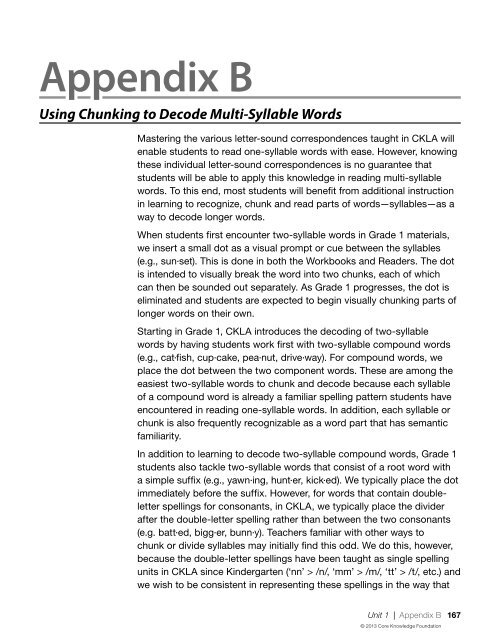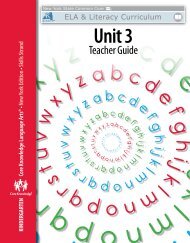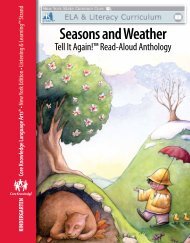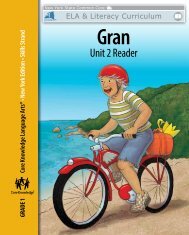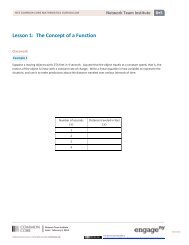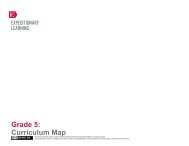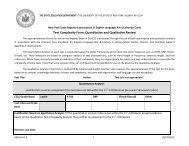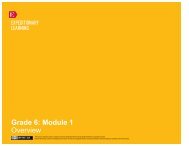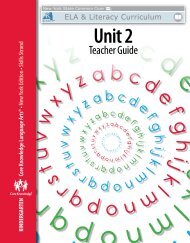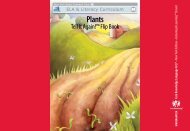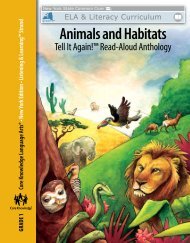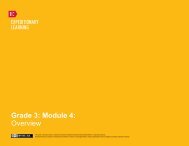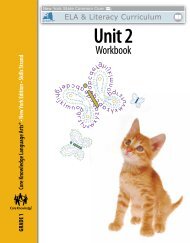Skills Unit 2 Teacher Guide - EngageNY
Skills Unit 2 Teacher Guide - EngageNY
Skills Unit 2 Teacher Guide - EngageNY
Create successful ePaper yourself
Turn your PDF publications into a flip-book with our unique Google optimized e-Paper software.
Appendix B<br />
Using Chunking to Decode Multi-Syllable Words<br />
Mastering the various letter-sound correspondences taught in CKLA will<br />
enable students to read one-syllable words with ease. However, knowing<br />
these individual letter-sound correspondences is no guarantee that<br />
students will be able to apply this knowledge in reading multi-syllable<br />
words. To this end, most students will benefit from additional instruction<br />
in learning to recognize, chunk and read parts of words—syllables—as a<br />
way to decode longer words.<br />
When students first encounter two-syllable words in Grade 1 materials,<br />
we insert a small dot as a visual prompt or cue between the syllables<br />
(e.g., sun·set). This is done in both the Workbooks and Readers. The dot<br />
is intended to visually break the word into two chunks, each of which<br />
can then be sounded out separately. As Grade 1 progresses, the dot is<br />
eliminated and students are expected to begin visually chunking parts of<br />
longer words on their own.<br />
Starting in Grade 1, CKLA introduces the decoding of two-syllable<br />
words by having students work first with two-syllable compound words<br />
(e.g., cat·fish, cup·cake, pea·nut, drive·way). For compound words, we<br />
place the dot between the two component words. These are among the<br />
easiest two-syllable words to chunk and decode because each syllable<br />
of a compound word is already a familiar spelling pattern students have<br />
encountered in reading one-syllable words. In addition, each syllable or<br />
chunk is also frequently recognizable as a word part that has semantic<br />
familiarity.<br />
In addition to learning to decode two-syllable compound words, Grade 1<br />
students also tackle two-syllable words that consist of a root word with<br />
a simple suffix (e.g., yawn·ing, hunt·er, kick·ed). We typically place the dot<br />
immediately before the suffix. However, for words that contain doubleletter<br />
spellings for consonants, in CKLA, we typically place the divider<br />
after the double-letter spelling rather than between the two consonants<br />
(e.g. batt·ed, bigg·er, bunn·y). <strong>Teacher</strong>s familiar with other ways to<br />
chunk or divide syllables may initially find this odd. We do this, however,<br />
because the double-letter spellings have been taught as single spelling<br />
units in CKLA since Kindergarten (‘nn’ > /n/, ‘mm’ > /m/, ‘tt’ > /t/, etc.) and<br />
we wish to be consistent in representing these spellings in the way that<br />
<strong>Unit</strong> 1 | Appendix B 167<br />
© 2013 Core Knowledge Foundation


